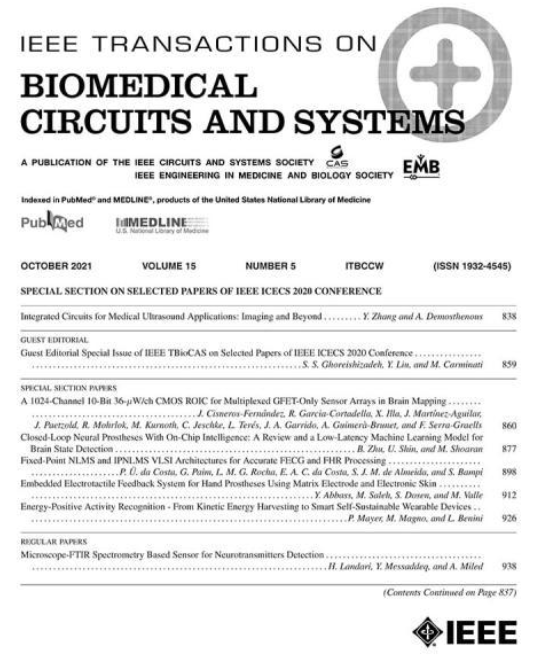双差动肌电有源电极分析及简单电路设计。
IF 4.9
2区 医学
Q2 ENGINEERING, BIOMEDICAL
IEEE Transactions on Biomedical Circuits and Systems
Pub Date : 1900-01-01
DOI:10.1109/TBCAS.2015.2492944
引用次数: 7
摘要
本文分析了双差动表面肌电信号测量所需的电压放大器,并设计了一种新颖、简单的双差动有源电极实现电路。独立DD有源电极需要的三输入放大器本质上不同于差分放大器,关于其设计的一般知识在文献中很少。首先,通过将放大器的输入信号分解成三个正交模式来确定放大器的性能指标。这一分析揭示了一个包含肌电串扰成分的模式,DD电极应该拒绝。然后,分析了有限输入阻抗的影响。由于有三个终端,因此获得了两个自由度的电极和输入阻抗不平衡引起的干扰抑制比的最小界限。最后,提出了一种新颖的电路设计,它只包括一个四倍运算放大器和几个无源元件。该设计几乎与分支电极一样简单,比三个仪表放大器设计简单得多,同时提供强大的肌电串扰抑制和更好的输入阻抗,每个电极输入使用单位增益缓冲器。分析了该输入级的抗干扰极限。本文描述了该电路的一个易于复制的实现,并提供了一个参数设计指南来调整它以适应特定的需要。将该电极与已建立的替代电极进行比较,并获得了样品表面肌电信号,这些信号是在具有干接点的不同身体位置上获得的,成功地抑制了干扰源。本文章由计算机程序翻译,如有差异,请以英文原文为准。
Analysis and Simple Circuit Design of Double Differential EMG Active Electrode.
In this paper we present an analysis of the voltage amplifier needed for double differential (DD) sEMG measurements and a novel, very simple circuit for implementing DD active electrodes. The three-input amplifier that standalone DD active electrodes require is inherently different from a differential amplifier, and general knowledge about its design is scarce in the literature. First, the figures of merit of the amplifier are defined through a decomposition of its input signal into three orthogonal modes. This analysis reveals a mode containing EMG crosstalk components that the DD electrode should reject. Then, the effect of finite input impedance is analyzed. Because there are three terminals, minimum bounds for interference rejection ratios due to electrode and input impedance unbalances with two degrees of freedom are obtained. Finally, a novel circuit design is presented, including only a quadruple operational amplifier and a few passive components. This design is nearly as simple as the branched electrode and much simpler than the three instrumentation amplifier design, while providing robust EMG crosstalk rejection and better input impedance using unity gain buffers for each electrode input. The interference rejection limits of this input stage are analyzed. An easily replicable implementation of the proposed circuit is described, together with a parameter design guideline to adjust it to specific needs. The electrode is compared with the established alternatives, and sample sEMG signals are obtained, acquired on different body locations with dry contacts, successfully rejecting interference sources.
求助全文
通过发布文献求助,成功后即可免费获取论文全文。
去求助
来源期刊

IEEE Transactions on Biomedical Circuits and Systems
工程技术-工程:电子与电气
CiteScore
10.00
自引率
13.70%
发文量
174
审稿时长
3 months
期刊介绍:
The IEEE Transactions on Biomedical Circuits and Systems addresses areas at the crossroads of Circuits and Systems and Life Sciences. The main emphasis is on microelectronic issues in a wide range of applications found in life sciences, physical sciences and engineering. The primary goal of the journal is to bridge the unique scientific and technical activities of the Circuits and Systems Society to a wide variety of related areas such as: • Bioelectronics • Implantable and wearable electronics like cochlear and retinal prosthesis, motor control, etc. • Biotechnology sensor circuits, integrated systems, and networks • Micropower imaging technology • BioMEMS • Lab-on-chip Bio-nanotechnology • Organic Semiconductors • Biomedical Engineering • Genomics and Proteomics • Neuromorphic Engineering • Smart sensors • Low power micro- and nanoelectronics • Mixed-mode system-on-chip • Wireless technology • Gene circuits and molecular circuits • System biology • Brain science and engineering: such as neuro-informatics, neural prosthesis, cognitive engineering, brain computer interface • Healthcare: information technology for biomedical, epidemiology, and other related life science applications. General, theoretical, and application-oriented papers in the abovementioned technical areas with a Circuits and Systems perspective are encouraged to publish in TBioCAS. Of special interest are biomedical-oriented papers with a Circuits and Systems angle.
 求助内容:
求助内容: 应助结果提醒方式:
应助结果提醒方式:


